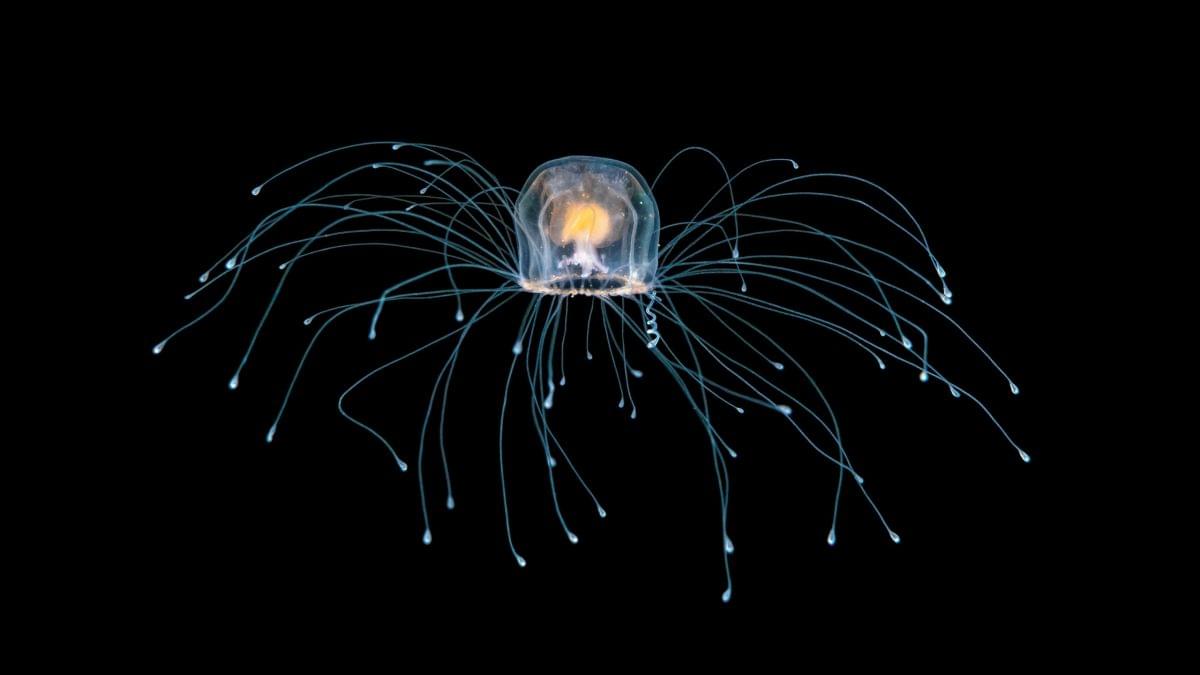Tortoises do not even make the list of the top ten longest-living animals.
The traits that allow the longest-living animals to delay, and sometimes even stop or reverse, the aging process are present. While humans may have a “absolute limit” of 150 years, this is a mere blink of an eye in comparison to the centuries and millennia that some animals live.
True age champions live in water, often at great depths where conditions are stable and consistent. Because scientists cannot record the birth and death of every member of a species, they typically estimate maximum life spans based on what is known about a species’ biology. Here are 12 of the world’s oldest-living animals, listed in order of age.
Sponsered5
1. HYDRA: POTENTIALLY IMMORTAL
Hydra are small invertebrates with soft bodies that resemble jellyfish and, like T. dohrnii, have the ability to live indefinitely. Because these invertebrates are largely composed of stem cells, which regenerate continuously through duplication or cloning, they do not deteriorate as they age. They do die in natural conditions due to threats such as predators and disease, but without these external threats, they could continue to regenerate indefinitely.
“They don’t seem to age, so they could be immortal,” said Daniel Martnez, a biology professor at Pomona College in Claremont, California, who discovered the hydra’s lack of aging.
Sponsered5
2. TURRITOPSIS DOHRNII: POTENTIALLY IMMORTAL
Turritopsis dohrnii is known as the immortal jellyfish because it has the potential to live indefinitely. Jellyfish begin life as larvae before settling on the seafloor and developing into polyps. These polyps then give rise to free-swimming medusas, also known as jellyfish. According to the American Museum of Natural History(opens in new tab), mature T. dohrnii can turn back into polyps if they are physically damaged or starved, and then return to their jellyfish state.
According to the Natural History Museum(opens in new tab) in London, the jellyfish, which are native to the Mediterranean Sea, can repeat this feat of reversing their life cycle multiple times and thus may never die of old age under the right conditions. T. dohrnii are small — less than 0.2 inch (4.5 millimeters) across — and are eaten by other animals, such as fish, or die in other ways, preventing them from achieving immortality.
Sponsered5
3. GLASS SPONGE: 10,000+ YEARS OLD
Sponges, like corals, are made up of animal colonies that can live for thousands of years. Glass sponges are among the world’s longest-living sponges. According to NOAA, members of this group are frequently found in the deep ocean and have skeletons that resemble glass, hence their name (opens in new tab). According to a 2012 study published in the journal Chemical Geology(opens in new tab), a glass sponge belonging to the species Monorhaphis chuni was approximately 11,000 years old. Other sponge species may be able to live for even longer periods of time.
4. BLACK CORAL: 4,000+ YEARS OLD
Sponsered5
Corals appear to be colorful underwater rocks and plants, but they are actually the exoskeletons of invertebrates known as polyps. These polyps continually multiply and replace themselves by producing a genetically identical copy, causing the coral exoskeleton structure to grow larger and larger over time. Corals are thus made up of multiple identical organisms rather than a single organism, so the life span of a coral is more of a team effort.
Deep-water black corals are among the corals that live the longest. According to Live Science, black coral specimens discovered off the coast of Hawaii have been radiocarbon dated to be 4,265 years old.
5. OCEAN QUAHOG CLAM: 500+ YEARS OLD
Sponsered5
The North Atlantic Ocean is home to ocean quahog clams (Arctica islandica). This saltwater species can live even longer than the freshwater pearl mussel, the other bivalve on this list. According to the National Museum Wales(opens in new tab) in the United Kingdom, one ocean quahog clam discovered off the coast of Iceland in 2006 was 507 years old. The ancient clam was given the name Ming because it was born in 1499, during the reign of China’s Ming dynasty (from 1368 to 1644).
“In the colder waters surrounding Iceland, the Ocean Quahog has a slower metabolism and thus grows slowly — scientists just haven’t found an older one yet!” In 2020, Anna Holmes, curator of invertebrate biodiversity (bivalves) at National Museum Wales, published an article on the museum’s website(opens in new tab).
6. TUBEWORM: 300+ YEARS OLD
Sponsered5
Invertebrates that live on the ocean floor are known as tube worms. According to the Woods Hole Oceanographic Institution’s Dive and Discover(opens in new tab) website, bacteria in their tubes produce sugars from chemicals, which they absorb as food. Some tube worms live near hydrothermal vents, but the longest-living species live in colder, more stable environments known as cold seeps, where chemicals spew from cracks or fissures in the seafloor, according to the University of Hawaii’s Exploring Our Fluid Earth(opens in new tab) website.
According to a 2017 study published in the journal The Science of Nature(opens in new tab), Escarpia laminata, a cold-seep species of tube worm in the Gulf of Mexico, can live for up to 200 years, with some specimens living for more than 300. Tube worms have a slow metabolism and few natural predators, which has allowed them to evolve such long life spans.
7. GREENLAND SHARK: 272+ YEARS OLD
Sponsered5
The Arctic and North Atlantic oceans are home to Greenland sharks (Somniosus microcephalus). According to the St. Lawrence Shark Observatory(opens in new tab), they can grow to be 24 feet (7.3 meters) long and eat a variety of other animals, including fish and marine mammals such as seals.
According to a 2016 study of Greenland shark eye tissue published in the journal Science(opens in new tab), these sharks can live for at least 272 years. According to Live Science, the oldest shark in that study was estimated to be 392 years old, and the researchers suggested that the sharks could have been up to 512 years old. The age estimates were subject to some uncertainty, but even the lowest estimate of 272 years makes these sharks the longest-living vertebrates on the planet.
8. FRESHWATER PEARL MUSSEL: 250+ YEARS OLD
Sponsered5
Bivalves that filter food particles from the water are freshwater pearl mussels (Margaritifera margaritifera). They are found in Europe and North America, primarily in rivers and streams. According to the World Wildlife Fund for Nature, the oldest known freshwater pearl mussel was 280 years old (opens in new tab). Because of their low metabolism, these invertebrates have long life spans.
The freshwater pearl mussel is a threatened species. According to the International Union for Conservation of Nature, their population is declining due to a variety of human-related factors, including damage and changes to the river habitats on which they rely (opens in new tab).
9. ROUGHEYE ROCKFISH: 200+ YEARS OLD
Sponsered5
According to the Washington Department of Fish and Wildlife, the rougheye rockfish (Sebastes aleutianus) is one of the longest-living fish, with a maximum life span of at least 205 years (opens in new tab). These pink or brownish fish can be found from California to Japan in the Pacific Ocean. According to the Committee on the Status of Endangered Wildlife in Canada(opens in new tab), an independent advisory panel that assesses the status of species threatened with extinction in Canada, they can grow to be 38 inches (97 centimeters) long and eat other animals such as shrimp and smaller fish.
A 2021 study published in the journal Science(opens in new tab) examined the genomes of 88 rockfish species, including rougheye rockfish, and discovered genetic markers for longevity, such as DNA repair pathways that may aid in cancer prevention. Rockfish with a longer life span can grow larger and produce more young.
10. BOWHEAD WHALE: POTENTIALLY 200+ YEARS OLD
Sponsered5
The longest-living mammals are bowhead whales (Balaena mysticetus). According to the National Oceanic and Atmospheric Administration (opens in new tab), the exact life span of Arctic and sub-Arctic whales is unknown, but stone harpoon tips found in some harvested individuals show that they comfortably live over 100 years and may live more than 200 years (NOAA).
Mutations in the whales’ ERCC1 gene, which is involved in repairing damaged DNA, may help protect the whales from cancer, a potential cause of death. Furthermore, a section of another gene called PCNA has been duplicated. This gene is involved in cell growth and repair, and the duplication may slow aging, as previously reported by Live Science.
11. RED SEA URCHINS: 200 YEARS OLD
Sponsered5
Red sea urchins (Strongylocentrotus franciscanus) are small, round, spine-covered invertebrates. According to Oregon State University, they live in shallow coastal waters off the coasts of North America, from California to Alaska, where they feed on marine plants (opens in new tab). Researchers used to believe that red sea urchins grew quickly and had short life spans of up to 10 years, but as scientists studied the species more closely, they discovered that these urchins continue to grow slowly and, in some locations, can survive for centuries if predators, disease, and fishers are avoided.
According to a 2003 study published in the journal Fishery Bulletin, red sea urchins found off the coasts of Washington and Alaska live for more than 100 years, and the longest-living individuals in British Columbia, Canada, may be around 200 years old (opens in new tab).
12. SEYCHELLES GIANT TORTOISE: 190+ YEARS OLD
Sponsered5
Tortoises are well-known for their longevity. Jonathan, a 190-year-old Seychelles giant tortoise (Aldabrachelys gigantea hololissa), is the oldest living land animal. The tortoise lives on the South Atlantic Ocean island of St. Helena, which was brought there by people from the Seychelles in 1882.
According to Guinness World Records, Jonathan became the oldest tortoise ever on January 12, 2022. (opens in new tab). “He is a local icon, symbolic of perseverance in the face of change,” said Jonathan’s veterinarian, Joe Hollins, at the time.
Sponsered5




